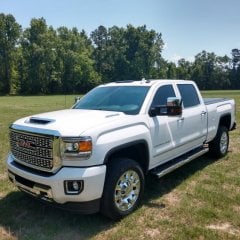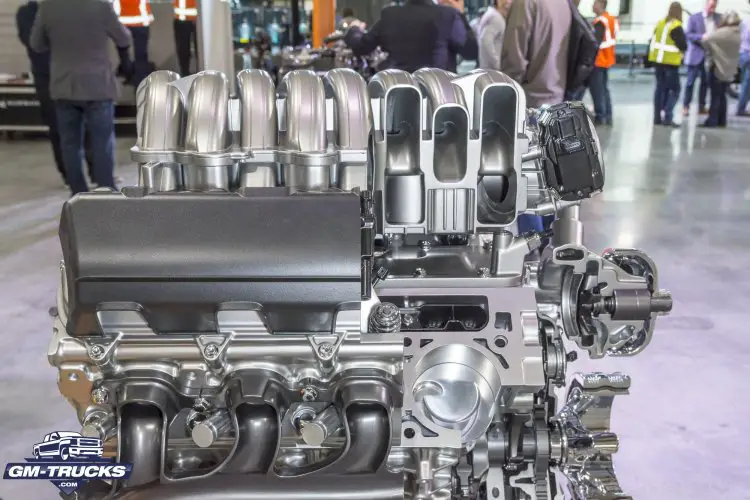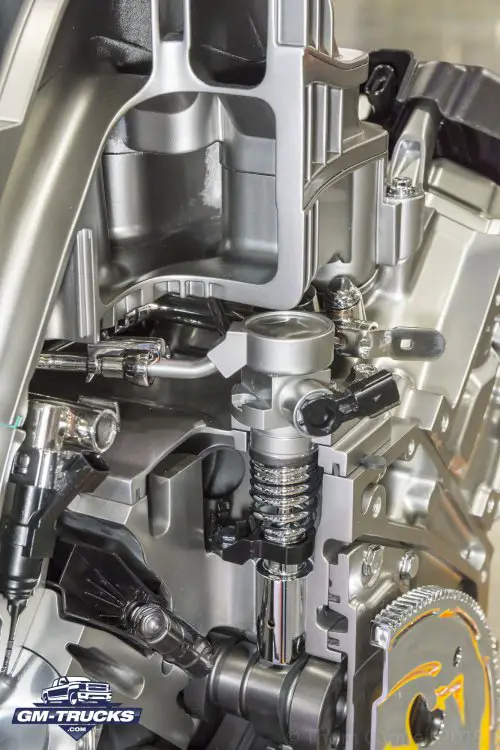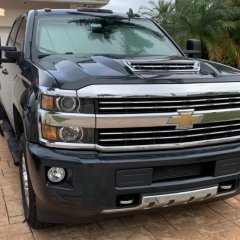Search the Community
Showing results for tags 'l5p'.
-
I've checked out a few threads on here trying to find a similar noise to what I've been dealing with but either haven't dug deep enough, or haven't found one making the right noise. Started about 3 months ago and periodically gets better than worse again, but notice it the most on hot days. Started with only doing this around 50-55 mph but has since progressed to starting right after it shifts through each gear. No codes, no real changes in driving quality (hot days a little sluggish), more so it's just annoying. The groaning seems to be coming from the passenger side somewhere but I haven't been able to pinpoint exactly where. I've had some people throw me ideas such as injectors, torque converter, heat shield vibrations, all sorts of things from all over the truck, so I'm at a loss with even the slightest idea of what it could be. Been running Diesel Kleen through it just about every other fill up and I'd say there is some difference, not enough for me to say it makes it smooth out. Link is a not super great video from a few weeks ago of said sound
- 1 reply
-
- l5p
- 2019 duramax
-
(and 1 more)
Tagged with:
-
New to the this forum but a seasoned vet on others. I’m posting to see if anyone else is having brake issues after the TSB for the brakes on the 3500 L5P. If not to keep an eye out. Long story short, we just finished a 12 day camping trip up the coast of California. On the last day we headed home which is 4 hours away pulling our 5th wheel. (2023 Momentum 395M). 30 minutes from home, We were getting on the interchange and noticed some clear white smoke corresponding with my break pumps. On the third pump I lower my trailer breaks thinking it was set too high cause of the steep grades. Pumped again and that’s when I got a steady white smoke. Pulled over right away and inspected to find fluid leaking in front of the driver rear tire and a small fire. First thing I do is shut off the truck. Run around and get my wife out of the truck so we can kids and dogs out. As I turn around my 4 year is strapped in his car seat with flames all up the rear door and back glass. It happened so slow and fast at the same time. All I could think about is that glass breaking and the oxygen sucking the flames in and watching my son burn to death in front of my eyes and I can’t do a damn thing. I did indeed get him out and the family in to the trailer. We were stuck in what I call the kill box now. It’s 2 major freeways that interchange in to a 2 lane highway with at least 1/4 of concrete barrier on both sides with no turn outs not too much further up. We were lucky to stop where we where. We tried to put out the fire out with 4 extinguishers between the truck driver, tow truck driver and myself with no anvil. At this point I have to either get my family out of the trailer or unhook and try to drive off. Well ….. we were able to unhook. Jumped in the truck knowing turning on the fuel pump was a terrible idea. The thought of my family sitting on the upper deck on top of 2 propane bombs under them just gave me the push I needed to commit. Turned her on and floored it. The truck had exploded with me in it. I still remember seeing the flames all around, the heat and smoke in the cab. I was able to exit the vehicle after that excess fuel to burn off. I suspect that the initial fire started on the passenger rear and moved to the driver rear. As there are tire stamps from the right rear some something hot, melting or leaking for over 80 feet. Where I stopped first. You could see that it was leaking where the tires would be. Puddle is wet on the right side and the left is burned. if fuel was leaking, there would be a fuel burn line or fire. This is what I think happened but we will have to wait and see what the experts say. We are very fortunate that there were no injury or fatalities. Insurance company has taken custody of the truck and investigation is pending. I only have 17k left on the loan and had 15k of parts and labor in to it. Mods were as follows. 35x12.5 wrapped on 20” Fuel Triton wheel, K&N drop in filter, S&B 62 gallon fuel tank, Retrax hard roll up bed cover, B&W 5th wheel hitch and custom mudflaps. All I know is that I almost lost my family, trailer and truck that I’m most likely going to lose on. 3500 was purchased certified used last June around 14,000 miles and burned down last Thursday with about 16k on it. Now the adrenaline and shock has worn off. The anger and ptsd is kicking in. We wouldn’t have gotten out with our skin suits with out the help of the kings if all kings …God, the 2 Good Samaritan and our great first responders. In the end of the day I have my family and health and thankful for that. I’ll be posting my outcome, as soon as I hear back and case is closed.
-
- 1
-

-
- break pressure switch
- fire
-
(and 9 more)
Tagged with:
-
I have a 2019 L5P with 72k on it. Bought it last June from a dealership with 51k on it. Few months ago, I tried to go get it aligned at a Big O and was told they couldn't do it because it needed new pitman, idler, and inner tie rods. Got it on the lift few days later and decided pitman and idler were getting replaced, but tie rods didn't seem bad. Bought the parts, took it to a reputable shop, and had them replace them and align it. They scoped out the tie rods and agreed they weren't bad. Fast forward to a week ago, truck is out of alignment again and has slowly been getting worse. I have play in my steering wheel, rides rough, and discovered today that my ball joint on my driver side lower control arm is leaking grease. Once again checked my tie rods and still mechanically appear fine. I won't lie, I do not know all there is to know about these trucks, and I've been learning as I go. With all this being said, I'm looking for any information, any tips, any things to look for, or even common problems that I may need to look out for in the future. I'm on my own trying to figure this all out and the only thing most other shops do around here is treat me like a dumb blonde chick. Last shop I took it to is booked out now for over a month or I'd go back there. Any help would be greatly appreciated.
-
No lights L5P back to shop
Jackie Emery Andrus posted a topic in 6.6L (LML/L5P) & 6.0L (L96/LC8) Tech
2018 Chevy 2500 LT. Unfortunately going back to shop for second time. Thank God I have warranty. Going for emissions related problems. First time Coolant reservoir need replaced. Also noticed that none of my mirror lights work. I'm wondering if this an issue I could fix myself easily? Led backup lights also wont turn on even when I turn on bed light and put in reverse. I hope warranty doesn't give me trouble. I did not have a problem the first time with warranty. But with this "Service Emissions System:. Along with lights not working in mirrors. And to top it off I must have some sort of short where license plate bulbs are at. Plate lights wont stay on even with new bulbs. -
Coming home from a four-hour trip Sunday towing a small utility trailer, my truck dropped to idle while at speed on the interstate just a few miles from home. I was lucky and able to pull over to an exit ramp with zero power. While coasting the display popped up saying reduced power for a couple of seconds and the engine light came on. While still on the exit, all power restored, message went away, and I was able to make it home on back roads. While it was still running I pulled three codes: P0087, P129F and P228B. Cut it off, unloaded everything and then went to move the trailer. It turned over for a few seconds then busted off (longer than normal). As soon as I put it in gear it shut off. Got it to the dealership and awaiting the results. Truck only has 1,404 miles on it and was delivered from Flint a few weeks ago. All displays read fine, fuel filter, DEF fluid, etc. Engine light still on. Just FYI to add to the list of L5P problems
- 9 replies
-
- l5p
- loss of power
-
(and 1 more)
Tagged with:
-
Thom Cannell Contributor, GM-Trucks.com March 7th, 2019 Heavy Duty trucks mirror the contest for market domination in light duty trucks. This year both GM and Ford announced significant upgrades to the engines powering their all new 2500 and 3500 HD trucks as each company upgraded their diesel engine, and delivered new gas engines. At GM, the launch event centered on Chevrolet, who brought in truck writers from every segment—popular to fleet management—to Flint, Michigan’s Flint Truck Plant. Flint is the original home of General Motors trucks and the spiritual and historical home of the UAW. So, Flint Truck Plant is receiving an all-new facility constructed and designed for just HD trucks, with the former truck assembly areas destined for warehousing and future projects. New L8T 6.6-Liter Gas Engine We first spoke to Mike Kociba, a GM engineer and part of the Small Block team to learn about the new 6.6-liter V-8 engine we'd been anticipating. Mike told us the new motor “is a marriage of the six-liter it replaces and an upgrade in technology levels to Gen 5 architecture.” A careful look will disclose similarities in key areas where GM has maximized their experience with the six-liter’s durability and improvements in performance levels derived from Gen 5 architecture. “Specifically, new here is the gray cast-iron block which is unique for this application, hyper-eutectic purpose-built pistons for this application and heavy-duty requirements, forged powdered-metal connecting rods, and a forged steel crankshaft,” Mike continued. The most significant change is the addition of Direct Injection. It’s all new, an industry first for the heavy-duty market and new to GM trucks. “When we added DI, we took the roughly 400 KPa fuel pressure from the low-pressure pump and dialed it up to roughly about 15 mPa for engine operation under key conditions,” Mike continued. “That allows us to increase compression ratio, now 10.8:1 using regular fuel. Without DI you're not going to hit those numbers without losing a lot of spark efficiency. With those additions, and the six millimeter longer stroke, that gets us up to 6.6-liters.” “That suite of changes allows us to hit class-leading gasoline engine torque, at 464 foot-pounds at a lower engine speed than the outgoing six-liter was optimized for. I'm proud of its 401 horsepower, which is SAE Certified, no games, legitimate. This (engine) is purpose-built to crank out those numbers day, after day, after day with no compromise in durability. Customers can have confidence they're going to pull, tow whatever trailer you need.” There are other new features like an all-new water pump and a massive cooling fan to meet the demands of the HD customer base. New is how the water pump drives the fan through a one-inch shaft using purpose-built bearings to handle loads. Another first for HD is a variable-output oil pump. “No mater what the severe operating condition is for the customer, the pump is capable of dialing in more, or less oil pressure regardless the requirement. The engine features an aluminum oil pan, nylon 6-6 air intake, and stainless steel exhaust manifolds unique for the Heavy Duty market. That’s because HD market has specific requirements for (fuel) enrichment and these stainless manifolds will meet those requirements. “We have variable dual-equal valve actuation, like on light duty, where intake and exhaust are phased together and controlled through the actuator on the front cover. It's chain driven for accessories.” GM designed this engine specifically for upcoming standards for particulates and NOx emissions standards. “With this architecture we're not just making power and torque, but improved emissions and improved efficiency.” Mike continued. We noted the massive valves, which Mike said are common with Gen 5 architecture for valve layout and their pushrod technology. “That's how we get this compact shape. When you compare the size of the two engines, they're similar, which is due to the common 4.4-inch bore spacing.” A unique feature of the new engine is inter-bore cooling. Coolant flows between the Siamesed bores, notably in the upper bores where there’s a tendency to generate higher temperatures. “For two-valve technology of course you've got the spark plug, and the fuel injector, splayed outside. To avoid heat, we have the coil mounted directly on the rocker cover and the boot mounted next to the manifold with industry-standard individual coils for each cylinder.” This is great stuff, we though, but engine development isn’t cheap. So, why a new 6.6-liter when the 6-liter was doing well? “We needed to improve to Gen 5 level of technology to be sure (the engine) is capable of delivering on durability requirements. Customers love the convenience of gas, but if you look at the market—for instance trailers with more gadgets and slide-outs—everything is getting heavier. Customers want to be sure they can tow with confidence, no compromises, whether it's fuel economy, power, torque, emissions, efficiency, they don't want to pull up to their neighbor and have to make excuses. That's what we targeted. No compromises. With the significant technology we put into this engine, it makes segment-leading torque without compromising efficiency or emissions. Peak torque is at 4,000 rpm, 400 rpm lower than the 6.0-liter. Three things enable the new 6.6-liter's better power output. Direct injection (DI) allows us a higher compression ratio; longer stroke is good for increased torque (but not as good for horsepower as piston speeds are high) and for heavy-duty application where you need torque everywhere it’s why we focused on a longer stroke to get to 6.6-liter displacement. Those changes enabled us to broaden the torque curve, which is up 20% everywhere, for greater work potential.” We thanked Mike and asked if we’d missed anything. “Small engines with turbochargers allow them peak torque off idle, but for heavy duty we don't want that complexity. For the Heavy Duty segment we (General Motors) have durability requirements—Global Engine Durability—that are unique and very long and stringent requirements. We know customers need 401 horsepower and 464 lb.-ft. of torque today, tomorrow, and every day for years to come with no compromise in durability. We know our customers and, if they can't use their truck today, they might not get paid. That's why we focus on durability.” Brand New HD 6-Speed Transmission With that in mind, we next spoke to the systems chief engineer for six-speed FWD and RWD transmissions Rich Mardeusz. More power and more torque tend to break an older transmission. So, we wanted to know what changes had been made to the new transmission to carry the additional torque. “We started with the 6L90 that's in the current HD vehicles and full-sized vans (and ZL-1 Camaro and CTS-V), received the horsepower and torque curves from the engine engineering teams and then performed an analysis of all mechanical components from front to back,” Rich said. General Motors uses specific simulation tools for different parts. “For instance, we have a "gear damage analysis tool" for analyzing the gear set and how much damage it may receive over the life of the vehicle,” Rich told us. The result was a need to improve the torque converter and the clutch pack, which needed to be more robust to accommodate the greater power output of the upgraded 6.6-liter V-8 engine. From a clutch pack standpoint, changes were simple, according to the engineer, as there was enough room in the case to add a clutch and one backing plate to each of the clutch packs to handle additional power. When it came to the torque converter, things changed. “We looked at the components from a heavy-duty diesel torque converter and a high-output gas torque converter and then took the torque-carrying components from the diesel and married them to the spring and damping components from the gasoline torque converter. That’s what was needed to accommodate the approximate 22 percent across-the-board torque increase.” So, the new torque converter can A) handle the added torque of the new engine and B) damp out the firing frequencies from the gasoline engine, which are significantly different from a diesel engine. All of the shafting and gears were able to handle the torque. Interestingly, there is no dipstick. GM has the confidence to eliminate it, and only change fluid at suggest intervals of approximately 100,000 miles, more often for those who mostly tow, or drive over mountains with full loads. Another surprise, the transmission uses GM-spec Dexron VI fluid, GMs standard since 2005, as they found no reason to change. 2019 L5P Duramax 6.6-Liter Once we’d completed our gas powertrain interviews, we turned to the diesel side of Heavy Duty. We spoke to Max Sala, whose Italian accent tipped us to an affiliation with GM’s diesel engine center of excellence in Turin, Italy. Max said that their objective for the new Silverado HD was to increase towing capacity and ensure functionality with the new Allison/GM transmission. Remember, the Duramax 6.6L Turbo-Diesel V-8 engine makes 445 hp. and 910 lb-ft of torque. “We added a bigger fan now 28-inches, a bigger oil cooler that is upgraded from 14 plates to 19 plates, and we fine-tuned the cylinder head gasket” Next up were improvements to the engine-brake capacity, taking into consideration towing capacity. “It’s better by 14-percent and we introduced smart activation of the engine brake,” Max continued, “There's still a button for manual activation, but for safety there's automatic activation at certain RPMs.” Under the new control system, the powertrain will recognize any need for the engine brake and activate automatically. For instance in driving down hill and forgetting to shift, the higher RPM means automatic activation. “With that, we have better after-run strategy. Every time you tow uphill, temps rise and you have a message to cool the engine when stopping. If, by chance you forget and close the door, the system cooling system activates automatically for up to 15 minutes to cool the engine for reliability.” That isn’t the end of changes, as the engine has been completely recalibrated to match the new 10-speed Allison transmission. “Emissions have been improved and fine-tuned to maintain the best efficiency the transmission can offer to our customers.” With these changes, most importantly, Chevrolet says they are now capable of delivering full torque at any time, in any gear, and that they have done everything to the engine, transmission, driveline, drive shaft and frame to improve strength and durability. “What's important is how safe (the new HD trucks) will be and how comfortable it will be for our customers to drive these huge trailers up, and down hills.” Max concluded. Allison transmissions have gained a peerless reputation for strength and durability. Adding a 10-speed transmission branded with the Allison name is a great choice. David Ames, now GM assistant chief engineer on the Allison transmission and liaison with Allison, is a former Allison engineer. A natural fit. The 10-speed is a collaborative effort with joint development of the analysis, engineering, as well as testing. So, testing was performed at Allison and at GM, each with their own set of rules and test regimes. “We go back and forth”, David told us. “Today we have a ratio-span of five and this transmission has a span of 7.2, so the new 10-speed provides both more overdrive and a lower first gear.” We asked about the projects’ starting point. “We (at GM) come out with a "here's what we're looking for" and we begin an internal development contract. It was a pretty clean sheet of paper. So, the controls on the bottom are from a smaller 10-speed, some pieces and parts, but not the entire controls package. For the most part, it's all new to handle the increased power and much larger torque. We collaborated with Allison on this transmission (GM does have a 10-speed transmission of its own) which made it necessary to meet their (Allison) design requirements, their analysis requirements, their engineering requirements, as well as our own. It's a very compact transmission. If you had a 6-speed for comparison, this more dense, more compact and solid to get ten speeds into a package that would still fit nicely into the vehicle and not take up too much space,” David continued. This transmission’s torque converter has a lock-up clutch and is unique in that it will lock up in first gear, even under max loads. So, if you're pulling 33,500 pounds, you can do a first gear launch and lock up right away, which helps get rid of heat. We asked David why this is important. “Normally in first gear you're under high torque and generating a lot of heat, which puts a lot of demand on the cooling system. Locking up gets rid of that heat and the 7.2 ratio gives you a lower first gear. For instance, the six-speed uses a 3.1 first gear and the new transmission has a much lower 4.5 first gear. It's got four planetary gear sets, six clutches and the main place you'll notice the ten speeds, not only in launches and driving with heavier loads—it's very smooth—is going down a grade. Often you're trying to downshift to save brakes and having ten gears you can usually hold the right speed and not feel like you're running over the car in front of you, tapping the brakes or going too slow.” “Also, we built in the first OEM PTO option. Note that the chain drive to the PTO is engine-speed driven rather than turbine-speed driven, which is important to many commercial customers, and it’s quieter drive than gear driven systems.” We asked David for an overview of the combined Duramax-Allison package. “For those who need it, it’s a nice package, one we're very proud of because of the outstanding durability. I think we're going to do a better job of putting power to the road than anybody out there. Whatever torque the engine is putting out, it's getting to the road in an accurate way. I think this transmission will be far more durable than people need it to be. Four-five years from now people will understand how durable it is.”
-
Just installed an S&B cold air intake #75-5103D with the (white) Dry extendable filter. Got it on amazon for 399$ same price as the S&B website , but shipping took 2 days with prime , S&B wanted 40$ to ship it standard. Installation was easy , and it looks really nice under the hood in my opinion, but better yet I can definitely hear the turbo whistle even more than stock. I still have the DPF and the catalytic behind the turbo so its not a nice full flowing whistle , but its loud enough to make me smile lol. Just wanted to create this thread for those with a Duramax (L5P) that were wondering on this CAI. I recommend It, I know is pricey , but most mods to these truck are. LMK if you have any questions ??
-
I now have 6,000 miles on my 2017 Duramax. Twice now I have had the 30% DEF caution come on and at the same time have had DEF mileage remaining warnings showing only 130 miles and 160 miles. On both occasions, the DEF level went from 30% to reading "Low" after about 50 miles, along with the caution that says something like "DEF Low - engine will soon be speed limited". In my 2015 Duramax, 30% DEF corresponded to approx 1000 miles remaining, now it seems to correspond to about 150 miles remaining. Also, assuming that the DEF tank was full when I got the truck and again full after a service where they said they topped up the DEF tank, both times I got the 30% DEF light after about 1000 miles of towing a 7500 lb travel trailer. I have now used 4 tanks of DEF in 6,000 miles (most of those miles towing the 7500lb travel trailer) Is this normal? Anyone else seeing this behavior? P.S. The first time this happened, I had to find DEF in the middle of nowhere, Montana, and filled up with some unknown brand of DEF. Shortly after I got a CEL The code was P0821). This happened again 3000 miles later. The fix, applied after the second incident) according to Chevy dealer was to reprogram the TCM and ECM.
-
Zane Merva Executive Editor / Publisher, GM-Trucks.com February 13th, 2019 GM only announced the all new 2020 L5P Duramax and 2020 Silverado/Sierra HD models a few weeks ago and we're already finding out more about them. This time Gale Banks has his hands on not one, but TWO L5P Duramax engines and takes one of them apart to explain what's different from the 2019 L5P engine. The video is over 13 minutes long but worth every second. Enjoy!
- 1 reply
-
- 2020 duramax
- duramax
-
(and 4 more)
Tagged with:




























